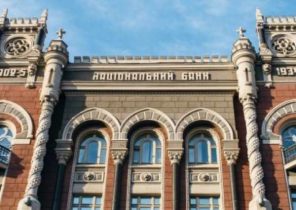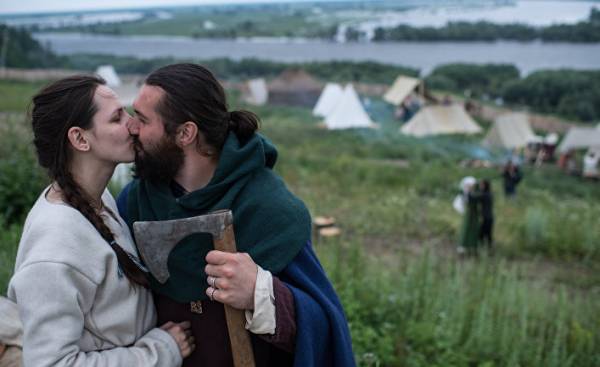
Translation carried out by the project Newочем.
Introduction: Myths about the Middle ages
About the Ages there are many historical myths. The reason for this lies partly in the development of humanism at the beginning of a New time, as well as the development of Renaissance art and architecture. Developed interest in the world of classical antiquity and the subsequent era was considered barbaric and decadent. So medieval Gothic architecture, which today is recognized as extremely beautiful and technically revolutionary, was undervalued and left out for styles that copied Greek and Roman architecture. The term “Gothic” was originally applied to the Gothic in a derogatory light, sloiv a reference to the tribes of the Goths plundered Rome; meaning of the word “barbaric, primitive”.
Another reason for the many myths associated with the middle Ages, is its relationship with the Catholic Church (the “Church” — approx. Newoчем). In the English-speaking world these myths have their origin in disputes between Catholics and Protestants. In other European cultures, such as Germany and France, similar myths have developed within an anti-clerical positions of influential thinkers of the Enlightenment. Below is a brief summary of some of the myths and misconceptions about the middle Ages, which arose as a result of various prejudices.
1. People believed that the Earth was flat and the Church taught this idea as doctrine
Actually the Church has never taught that the Earth is flat, none of the Medieval period. Scientists of the time had a good idea of the scientific arguments of the Greeks that proved the Earth was round and could use scientific instruments such as the astrolabe, to accurately determine the circumference. The fact of the spherical form of the Earth was so well known, universally accepted and unremarkable that when Thomas Aquinas began work on his treatise “the Amount of theology” and wanted to choose an objective undeniable truth, he cited this very fact.
And about the shape of the Earth was knowledgeable not only literate people — most of the sources indicate that all is understood. The symbol of the earthly power of kings, which was used in the ceremonies of coronations, was the Orb: a Golden sphere in his left hand the king who personified the Earth. This symbolism would not make sense if it was not clear that the Earth is spherical in shape. In the collection of German sermons of parish priests of the XIII century are also briefly mentioned that the Earth is “round like a Apple” with the expectation that the peasants hearing the sermon, you know what it’s about. And the popular fourteenth century English book “the adventures of Sir John Mandeville”, is about a man who went so far East that he returned home on its Western side; and the book does not explain to the reader how it works.
A common misconception that Christopher Columbus discovered the true shape of the Earth, and that the Church opposed his journey, there is nothing like a modern myth created in 1828. Writer Washington Irving was commissioned to write the biography of Columbus by stating that he presented the traveller as a radical thinker, a rebel against the prejudices of the Old world. Unfortunately, Irving found out that Columbus actually was mistaken in the size of the Earth and discovered America by pure chance. The heroic story did not add up, and so he invented the idea that the Church in the middle Ages thought the Earth was flat and created this tenacious myth, and his book became a bestseller.
Among the collection of quotations found on the Internet, you can often see an estimated statement of Ferdinand Magellan: “the Church declares that the Earth is flat, but I know that it is round. Because I have seen the Earth’s shadow on the moon, and I trust the Shadow more than the Church.” So, Magellan never said this, in part because the Church has never claimed that the Earth is flat. The first use of this “quote” is found no earlier than 1873, when it was used in an essay American Valeriana (valerianic — freethinking philosopher — approx. Newoчем) and agnostic Robert green & Country. He did not indicate any source and it is highly likely that he simply invented the quote. Despite this, “the words” Magellan can still be found in various collections, posters and t-shirts of organizations of atheists.
2. The Church suppressed science and progressive thinking, burned scientists at the stake, and thus set us back hundreds of years ago
The myth that the Church suppressed science, burned or suppress the activities of scientists is a Central part of what historians who write about science, called “a clash of ways of thinking”. This persistent concept originated in the Enlightenment, but became established in the public mind with two well-known works of the nineteenth century. The writings of John William Draper’s “History of relations between Catholicism and science” (1874) and Andrew Dickson white, “the Struggle of religion with science” (1896) was very popular and influential books, spreading the belief that the medieval Church actively suppressed science. In the twentieth century, historians of science have widely criticized “the white-Draper” and that is a big part of the evidence was grossly misinterpreted, and in some cases even invented.
In the era of late Antiquity, early Christianity do not welcomed the fact that some clergy were called “pagan knowledge”, that is, the scientific work of the Greeks and their Roman successors. Some preached that a Christian should avoid these works, for they contain non-biblical knowledge. In his famous phrase, one of the Fathers of the Church, Tertullian sarcastically exclaims: “What does Athens have to Jerusalem?”. But such ideas were rejected by other prominent theologians. For example, Clement of Alexandria argued that if God had given the Jews a special understanding of spirituality, he could give the Greeks a special understanding scientific things. He suggested that if the Jews took it and used the gold of the Egyptians in their view, Christians can and should use the wisdom of the pagan Greeks as a gift from God. Later the arguments of Clement had the support of Aurelius Augustine and later Christian thinkers adopted this ideology, noting that if the cosmos is the creation of a thinking God, he can and should be apprehended in a rational way.
Thus natural philosophy, which is largely based on the works of such Greek and Roman thinkers like Aristotle, Galen, Ptolemy, and Archimedes, was the main part of the medieval universities. In the West, after the collapse of the Roman Empire, many ancient writings have been lost, but Arab scientists were able to keep them. Later medieval thinkers was not just studying the additions made by the Arabs, but enjoyed them, discovering. Medieval scholars were fascinated by optical science, and the invention glasses is only partly a result of their own research with the use of lenses to determine the nature of light and physiology of vision. In the XIV century philosopher Thomas Bradwardine and a group of thinkers called themselves “the Oxford calculators” not only first formulated and proved a theorem about the average speed but also pioneered the use of quantitative concepts in physics, laying thus the Foundation for all that has been achieved in this science ever since.
All the scientists of the middle Ages not only were persecuted by the Church, but they themselves belonged to her. Jean Buridan, Nicholas OREM, Albrecht III (albert the Bold), albert the Great, Robert Grosseteste, Theodoric of Freiburg, Roger bacon, Thierry of Chartres, Sylvester II (Gerbert Orlanski), William Kongese, John Philopon, John Packham, John Duns Scott, Walter Burley, William Heytesbury, Richard Swished, John Dumbleton, Nicholas of Cusa — they were not pursued, resisted and was not burned at the stake, but I knew and respected for their wisdom and scholarship.
Contrary to myths and common prejudice, there is no example, in the Middle ages when someone was burned for anything associated with science, as there is no evidence of persecution of any scientific study of the medieval Church. The trial of Galileo happened much later (the scientist was a contemporary of Descartes) and was much stronger associated with the policy of Counter-reformation and involved with people than with the Church’s attitude to science.
3. In the middle Ages, the Inquisition burned millions of women, considering them witches, and the burning of “witches” in the Middle ages, commonplace
Strictly speaking, a “witch hunt” was not a medieval phenomenon. The climax of persecution was reached in the XVI —XVII centuries and is almost completely belonged to the early period of the New time. As for the most part of the middle Ages (i.e., V-XV centuries), the Church is not only interested in hunting for the so-called “witches”, but it is also taught that witches do not exist in principle.
Until about the XIV century, the Church scolded believing in witches and people in General called such a silly peasant superstition. A number of medieval codices, the canonical and the profane, forbidden is not so much witchcraft as the belief in his existence. Once the priest entered into a debate with the inhabitants of one village, who sincerely believed in the words of the woman who claimed she was a witch and, among other things, may turn to smoke and leave a locked room through the keyhole. To prove the folly of this belief, the priest shut himself in the room with this woman and strikes with a stick, forcing her to leave the room through the keyhole. “Witch” is not escaped, and the villagers learned a lesson.
© REUTERS Mike Blake/FilesРадиоуправляемая witch over the Pacific ocean
The attitude of the witches began to change in the XIV century, especially in the midst of a plague epidemic of 1347 — 1350 years, after which the Europeans have become more and more afraid of a conspiracy of malicious demonic powers, most of them imaginary. In addition to the persecution of the Jews and intimidation against groups of heretics, the Church began to take more seriously covenham witches. The crisis came in 1484, when Pope innocent VIII published the bull Summis desiderantes affectibus (“All the forces of the soul” — approx. Newочем) that launched the witch-hunts that raged throughout Europe for the next 200 years.
At the beginning of the persecution of witches were involved equally in Catholic and Protestant countries. Interestingly, witch-hunt seems to follow geographical lines of the reformation: Catholic countries which is not particularly threatened Protestantism, such as Italy and Spain, the number of “witches” was small, but the country on the front lines of religious struggle of that time, like Germany and France, have experienced the brunt of this phenomenon. That is, the two countries where the Inquisition was most active were the places where associated with the witch hysteria was the smallest. Contrary to the myth, the inquisitors were far more concerned with heretics and re-converted to Judaism converted Christians-Jews than some “witches”.
In Protestant countries, witch-hunt was a violent flash when the status quo was under threat (like the witch hunt in Salem, Massachusetts), or during social or religious instability (as in Jacobin England or under the Puritan regime of Oliver Cromwell). Despite wildly exaggerated claims about “millions of women”, executed on charges of witchcraft, modern historians estimated the real number of victims approximately 60-100 thousand people for several centuries, and 20% of the victims were men.
Hollywood has perpetuated the myth of “medieval” witch hunts, and few Hollywood movies that tell about this period, is able to resist the temptation and not to mention witches or anyone, pursued by a creepy priest for witchcraft. And this despite the fact that almost the entire period of hysteria followed the middle Ages, and the belief in witches was considered superstitious nonsense.
4. The middle ages was a period of filth and poverty, people rarely bathed, smelled disgusting, and they had rotten teeth
In fact, medieval people of all classes showered daily, took baths and valued cleanliness and hygiene. As with any generation, to a modern system with hot running water, they were not as clean as we are, but how our grandparents and their parents, they were able to bathe daily, keep yourself clean, appreciated her and loved people who did not wash or smelled bad.
Most people in that era kept himself clean, washing daily in the baths with hot water. Use soap first became widespread in the Middle ages (the Greeks and Romans did not use soap), and soap manufacturers had their own guilds in most large medieval cities. Heating water for a full bath, took a lot of time, so home baths were not so common, but even the lowest stratum of society has adopted sedentary waist bathtubs, when provided the opportunity. The aristocracy raised bathing to a high levels of luxury, where such bathing in large wooden tubs with upholstered silk seats was not only a solitary pleasure, but also a process that can be shared with sexual partners or even groups of friends, with wine and food on hand — it is very similar to the modern bath or whirlpool.
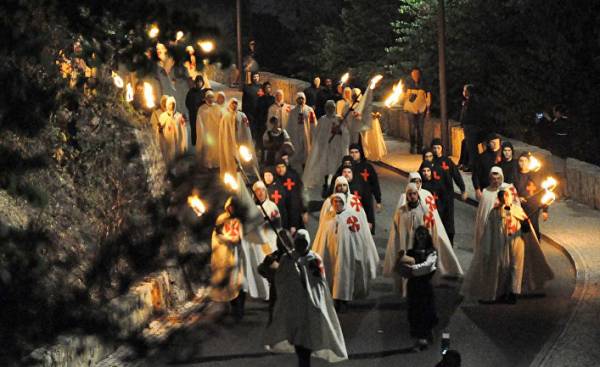 © public domain, Jaimrsilva/wikipediaФестиваль of the knights Templar – a Medieval Parade
© public domain, Jaimrsilva/wikipediaФестиваль of the knights Templar – a Medieval Parade
Public baths existed in many towns and cities, they flourished in hundreds. South Bank of the Thames was the site of hundreds of “corned beef” (from the English. “stew — stew”, hence the name of dishes in English — approx. Newoчем), in which medieval Londoners could bathe in hot water, to talk, to play chess and to stick to prostitutes. In Paris these baths were even more, and in Italy there were so many that some of them advertised themselves as serving exclusively women or aristocrats, nobles chance to not be in the tub with the workers or peasants.
The idea that people of the middle Ages did not wash is based on a number of myths and misconceptions. First, then XVI century and the XVIII century (i.e., after the middle Ages) were the periods when doctors claimed that taking a bath is harmful, and people tried to do it too often. Ordinary people, for whom “the Middle ages” starts “from the XIX century and earlier,” made an assumption that irregular bathing was common in the past. Second, Christian moralists and priests of the middle Ages did warn about the dangers of excessive bathing. This is due to the fact that these moralists warned against excess in everything — food, sex, hunting, dancing, and even repentance and religious commitment. To conclude from this that no one bathed, completely pointless.
Finally, the public baths were closely associated with prostitution. There is no doubt that many prostitutes offered their services to the medieval public baths, and “stew” of London and other cities were close to the most famous for its brothels and hookers areas. Therefore moralists and cursing in public baths, including their Nativity scenes. To conclude, this is why people did not use public baths so stupid as to conclude that they visited the nearby brothels.
The facts that medieval literature glorifies the charm of bathing that the medieval ceremony of knighting includes aromatic bath to dedicate squire, ascetic hermits prided failure from swimming to the same extent as a waiver of other social pleasures, and mildely and owners baths staged noisy trading performance, shows that people like to keep themselves clean. Archaeological excavations confirm the absurdity of the idea that they had rotten teeth. Sugar was an expensive luxury, and the diet of the average person was rich in vegetables, calcium, and seasonal fruits, so in fact, medieval teeth were in excellent condition. More cheap sugar flooded the markets of Europe in the XVI-XVII centuries, which caused an epidemic of tooth decay and bad breath.
A medieval French saying demonstrates how fundamental it was for the bathing pleasures of the good life:
Venari, ludere, lavari, bibere! Hoc est vivere!
(Hunt, play, swim, drink! That’s how life should be lived!)
5. The middle ages — a dark period with respect to technological progress, which virtually nothing was created until the Renaissance
In fact in the Middle ages had made many discoveries, proving the technological process, some of which are on a par with the most significant in the history of mankind. The fall of the Western Roman Empire in the V century a devastating impact on the entire material and technological culture of Europe. Without the support of the Empire, many ambitious engineering and infrastructure projects, as well as many of the skills and techniques involved in the monumental buildings have been lost and forgotten. The rupture of trade relations meant that people became more economically independent and produce everything you need yourself. But it is rather stimulated the introduction and development of technology, rather than Vice versa.
Technical progress has helped Autonomous rural communities to increase the popularity of such unions throughout Europe that led to the development of the clamp allowing for more efficient transportation and plowing; there was also the horseshoe dump plow, which made possible the cultivation of heavier Northern European soils, water, and tidal mills were used everywhere. As a result of these innovations, much of the land throughout Europe, never cultivated during the Roman conquest, began to be processed, whereby Europe has become richer and more fertile than ever.
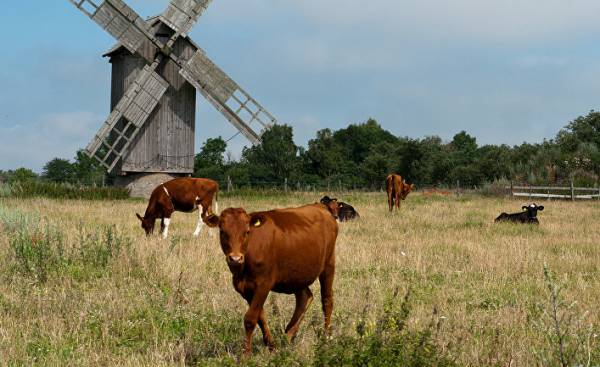 © flickr.com, JumillaСтарая mill on the island of Gotland
© flickr.com, JumillaСтарая mill on the island of Gotland
Water mills were introduced widely in scale, incomparable to the Roman era. This not only led to extensive use of hydropower, but also to the active surge of mechanization. The windmill is an innovation of medieval Europe, along with water used not only for grinding flour, but also for the production of cloth, the manufacture of leather goods, driving bellows and a mechanical hammer. The last two innovations have caused steel production to semi-industrial scale and, along with the medieval invention of the blast furnace and cast iron medieval advanced production technology of metal far away from the era of Roman conquest.
The second half of the middle Ages (1000 — 1500 years) wind and hydropower produced the agrarian revolution and transformed Christian Europe in the rich, densely populated and ever-expanding terrain. Medieval people began to experiment with different ways of mechanization. When they noticed that the warm air causes the oven to work (another invention of the Middle ages), in large medieval kitchens were installed on the furnace fan to automatically turn the spit transmission systems. The monks of that time noted that the use of the gear system driven by a falling weight can be used for mechanical measurement of hours of time.
In the XIII century, throughout Europe began to appear mechanical watch — revolutionary medieval invention that allows people to keep track of time. The innovation spread rapidly, and miniature table clock began to appear only a few decades after the invention of the tool. Medieval clock could unite computing devices. Extremely complex mechanism of the astronomical clock designed by Richard of Wallingford, Abbot of the monastery of St Albans, was so complex that it took eight years to study the full cycle of calculations, and it was the most sophisticated device of its kind.
The increase in the number of universities in the Middle ages also stimulated the emergence of some technological innovations. Students studying optical studies of Greek and Arabic scientists did experiments on the nature of light in lenses, and in the process invented glasses. The universities also provided the market with books and contributed to the development of cheaper methods of printing. Experiments with block printing eventually led to the invention of the artificial script and another wonderful medieval innovation — the printing press.
The very existence of medieval shipping technology meant that the Europeans were the first to sail to America. Long trading voyage led to the increase in size of ships, although the old form of ship rudders — they were huge, in the form of a paddle mounted on the side of the ship limiting the maximum size of the vessel. At the end of the XII century ship carpenters invented the wheel mounted on the stern with the hinge mechanism, which allowed to build much larger ships and manage them more efficiently.
It turns out that the middle Ages were not only dark period in the history of technology development, but also managed to give life to many technological inventions, such as eyeglasses, mechanical clocks and the printing press — one of the most important discoveries of all time.
6. Medieval army was a disorganized group of knights in armor and a massive crowd of peasants, armed with pitchforks, led to a fight, more like street fights. That’s why the Europeans during the Crusades, many died at the hands of the tactically superior Muslim
Hollywood created the image of a medieval battle as a messy chaos in which greedy for glory ignorant knights controlled the regiments of peasants. This view has spread through the book of sir Charles Oman’s “the Art of warfare in the Middle ages” (1885). As a student in Oxford, Oman wrote an essay, later developed into a product and became the first published book by the author. She later became the most widely read English-language book on the topic of medieval warfare, largely because he was the only one of its kind until the first half of the 20th century, when began a more systematic study of the question.
The study Oman is very was losing weight due to unfavorable factors of the time, which worked author: a General prejudice that the middle Ages is the period of dark and undeveloped in comparison with the antique, the lack of sources, many of which had to be published, and a tendency not to check the received information. As a result, the depicted Oman’s medieval warfare how ignorant fight without a tactic or strategy that is being waged for the conquest of fame among the knights and noble men. However, by 1960, more modern techniques and a wide range of sources and interpretations could shed light on the middle Ages, initially by European historians in the face of Philip, and J. Contamines. F. Verbruggen. New research has literally revolutionized the understanding of the medieval warfare and demonstrated that while the majority of attention was focused on the personal actions of the knights and nobility, the use of other sources have painted a very different picture.
© RIA Novostiukraine fight
In fact, the rise of the knightly elite in the tenth century meant that in medieval Europe there was a special class of professionally trained soldiers, ready to dedicate his life to the art of warfare. While some gained fame, others are trained from childhood and knew that the battle won by organisation and tactics. The knights were prepared for performance in the foot troops, and the nobility to control these forces (often referred to as “the lances”) on the battlefield. This was controlled by using signals of a pipe, flag and set of visual and verbal commands.
The answer to the tactics of medieval battle lies in the fact that in the heart of the enemy army — the infantry — formed enough holes and heavy infantry could inflict on her a decisive blow. This step should have been thoroughly checked and maintained to ensure the protection of their own army, not to give the opponent opportunities to do the same trick. In contrast to popular opinion, medieval army consisted mainly of infantry and cavalry, including the elite heavy cavalry component of the minority.
The Hollywood idea of medieval infantry as a crowd of peasants armed with agricultural implements, also nothing like the myth. Infantry were recruited from recruits in the countryside, but intended for service men or was not trained or were poorly equipped. On land, where he was declared General conscription, were always men ready in a short time to prepare for war. English archers who won the battle of Crecy, Poitiers and Agincourt, was a peasant recruits, but they were well trained and very effective in the case of force majeure.
The authorities of the Italian cities left one day a week to prepare residents for performance in the infantry. In the end, many chose the military art as a profession, and the nobility often charged money from his vassals on account of taxes for military purposes and used the money to replenish the ranks of the army of hired soldiers and people who possess specific types of weapons (e.g. a crossbow or a masters of siege weapon).
Decisive battle often was a huge risk and could not succeed even if your army outnumbered the enemy army. As a result, the practice of open battle were rare for the middle Ages, most wars were a strategic manoeuvres, and often a long siege. Medieval architects raised the art of building a fortress to a new level: the great castles of the era of the Crusades, as Kerak and Krak de Chevalier, or a chain of massive buildings of Edward the First in Wales are the masterpieces of defensive design.
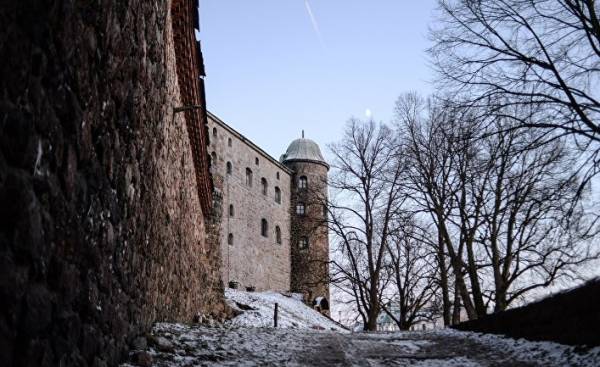 © RIA Novosti, Konstantin Chalabov | go to photolanguage castle in Vyborg
© RIA Novosti, Konstantin Chalabov | go to photolanguage castle in Vyborg
Along with the myths of medieval armies, when the mob controlled incompetent idiots goes to war, there was the idea that the crusaders were lost in battles with tactically more prepared opponents from the Middle East. Analysis of the battle, the crusaders held shows that they just won more battles than lost using the tactics and weapons of each other, and it was absolutely equal struggle. In reality, the cause of the fall of the crusaders of Outremer was the lack of human resources rather than primitive fighting skills.
In the end, there are myths about the medieval weapons. A common misconception is that medieval weapons were so enormously heavy that knights had to sit in the saddle a kind of lifting mechanism, and that the knight dropped from his horse, and could not get up. Of course, only an idiot would have gone to battle and risked his life in the armor so prevent movement. In fact medieval armor weighed a total of about 20 kg, which is almost half the weight which is on the front off a modern infantry. Re-enactors battle in our day like to perform acrobatics, demonstrating how fast and maneuverable can be fully geared warrior. Previously, the armor weighed much more, but even a trained person was quite mobile.




